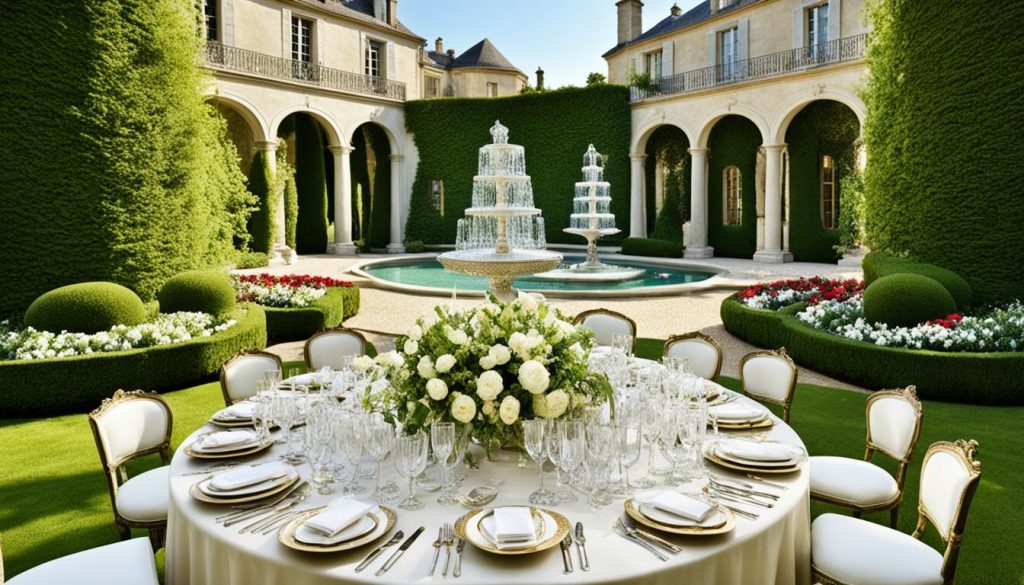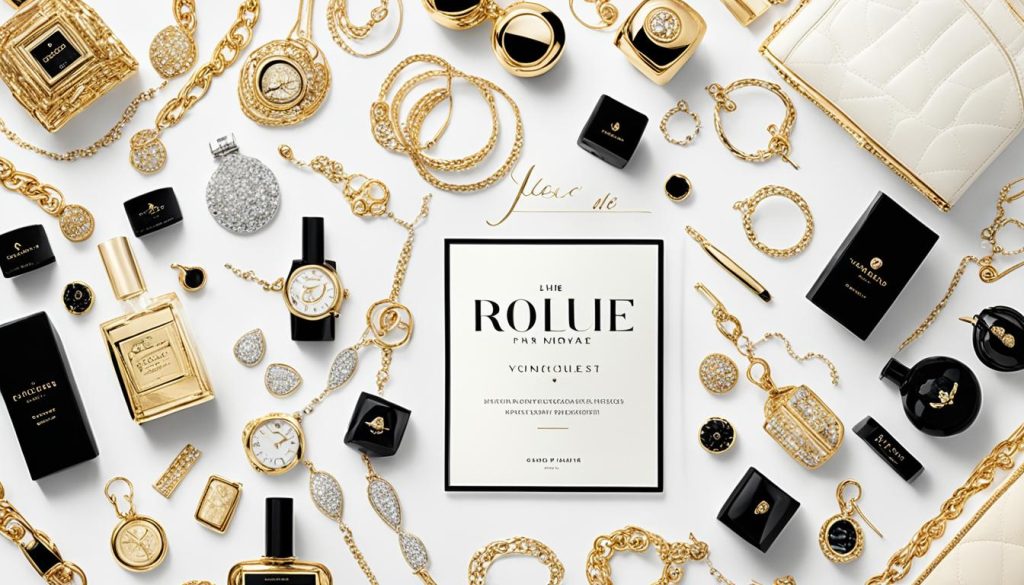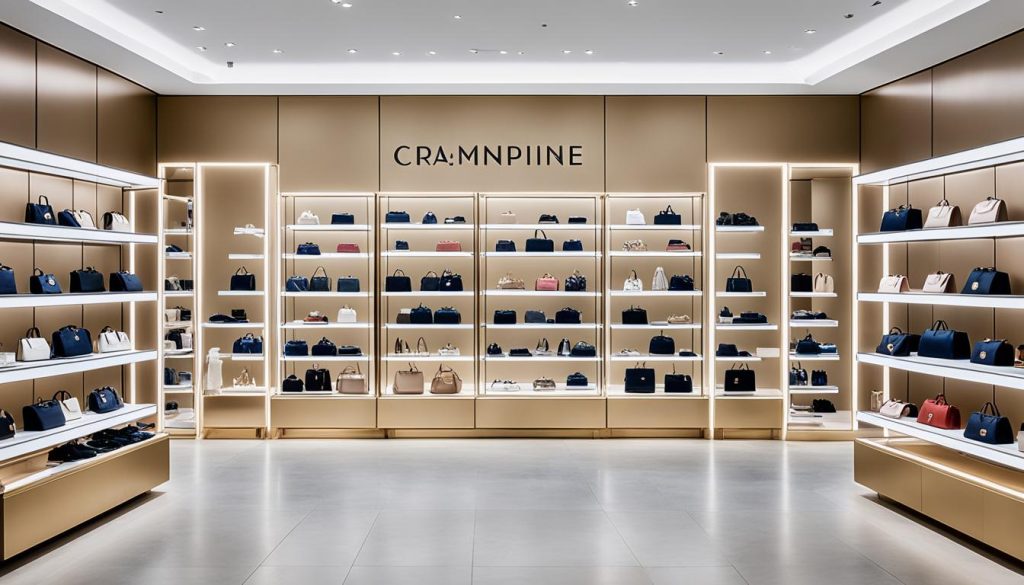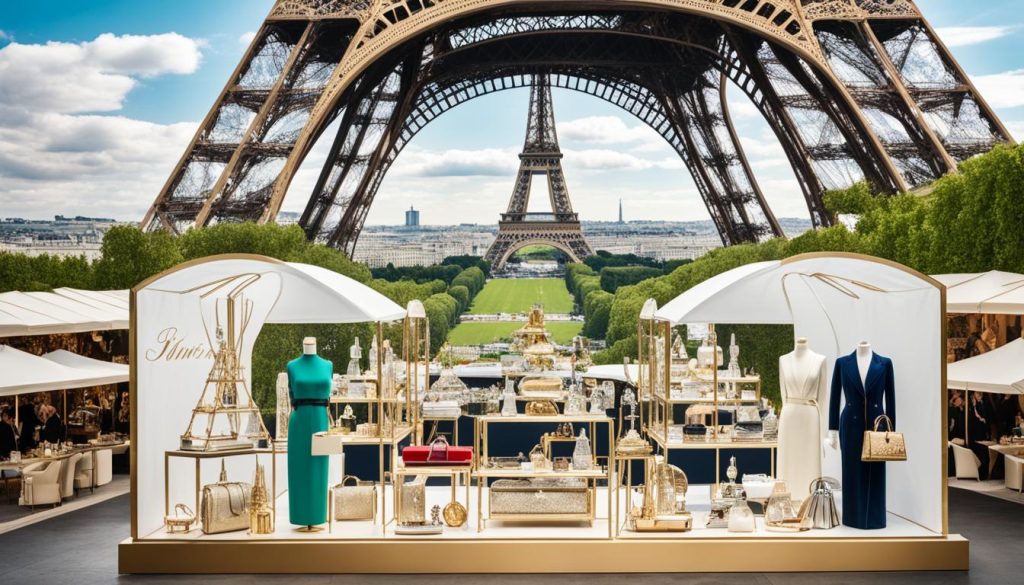Welcome to our deep dive into the French luxury market. It’s a major player in the world’s luxury scene. France shapes global fashion and prestige with its history, skilled craftsmanship, and famous brands. This market is thriving and changing all the time.
The rise of the French luxury market is intriguing. It’s shaped by new consumer trends, tech updates, and global movements. We’ll look into France’s luxury history, the key market leaders, and what drives its growth.
Key Takeaways:
- The French luxury market holds great importance in the global fashion and prestige industries.
- It is characterized by rich history, unparalleled craftsmanship, and iconic brands.
- Factors like changing consumer preferences and technological advancements contribute to the growth of the market.
- The market’s influence extends beyond France and has a significant impact on global fashion trends.
- Luxury tourism in France further boosts the market’s growth and reputation.
The Historical Context of French Luxury
To grasp the French luxury market today, we must explore its deep history. France is famous for its unmatched style, top-notch craftsmanship, and love for luxury. This began in the 17th century, during King Louis XIV’s time, who was known as the Sun King.
Back then, France became the heart of style and elegance. This made it a leader in luxury worldwide. The French royal court was all about wealth and splendor, with the king leading in fashion and luxury. Craftsmen from France were in demand, making items for Europe’s rich and royal.
The 19th century’s industrial revolution boosted the French luxury sector. New making and moving methods meant more luxury goods could be made and sent around. Brands like Chanel, Dior, and Louis Vuitton started, making France a key place for luxury.
A key part of French luxury is keeping its long history and customs. Many luxury brands here have been around for ages, keeping their skill and methods in the family. This focus on tradition makes French luxury items rare and sought-after.
Seeing the Palace of Versailles is key to understanding French luxury. This magnificent palace shows the luxury and elegance of French royalty. It highlights France’s big role in the luxury world.
The story of French luxury is the base of its success today. The French luxury sector keeps leading in fashion and craftsmanship. It continues to win over buyers from all over the globe.
Key Players in the French Luxury Market

In the French luxury market, several top brands lead the way. They are known for their craftsmanship, innovation, and stylish creations. They shape the world of French luxury with their high-end fashion, jewelry, and accessories.
Louis Vuitton is a standout name in this sector. It’s famous for its iconic monogram and classic designs. Since 1854, Louis Vuitton has been a symbol of sophistication and French elegance.
Another big name is Chanel. Created by Gabrielle Chanel in 1910, this brand changed fashion with its classic suits and the famous Chanel No. 5 perfume. Chanel’s designs and fragrances are everywhere.
Big groups like LVMH and Kering also play a crucial role. LVMH, under Bernard Arnault, boasts brands like Louis Vuitton and Christian Dior. Kering, led by François-Henri Pinault, includes Gucci and Saint Laurent. These conglomerates own several well-known luxury brands.
Hermès is famous for its top-quality leather goods and scarves. Cartier is known for its luxurious jewelry. Together, they add to the diversity of the French luxury market.
Let’s examine some major French luxury market brands:
| Brand | Specialty | Founded |
|---|---|---|
| Louis Vuitton | Leather goods, fashion | 1854 |
| Chanel | Fashion, accessories, perfume | 1910 |
| LVMH | Luxury conglomerate | 1987 |
| Kering | Luxury conglomerate | 1963 |
| Hermès | Leather goods, accessories, fashion | 1837 |
| Cartier | Jewelry, watches | 1847 |
The Iconic Louis Vuitton Monogram
The Louis Vuitton Monogram is a world-famous luxury symbol. Created in 1896 by Georges Vuitton, it includes LV initials and floral patterns. This design, inspired by Art Nouveau, shows the brand’s commitment to excellence.
Factors Driving the Growth of the French Luxury Market
The French luxury market has grown a lot recently. This growth comes from many factors that help it succeed worldwide. These factors show how the industry changes to meet what consumers want, uses smart marketing, and gets more global interest in luxury products.
Evolving Consumer Preferences
One main reason for its growth is how consumer tastes have changed. High-end buyers now want real, well-made, and eco-friendly products. French luxury brands, known for their long history, classic design, and high quality, have attracted these buyers. They offer unique and special products that match people’s values.
This change has also made sustainable luxury more popular. Many French brands are now more eco-friendly. They use greener materials, reduce waste, and support fair work practices. This attracts buyers who think it’s important to buy sustainably.
Increasing Global Demand
Another big reason for the growth is more global demand for luxury goods. The charm of French luxury is worldwide, drawing in rich buyers from everywhere. With more people getting wealthier in places like China and India, there’s a bigger demand for these goods than ever.
French luxury brands have grown their global presence in response. They use online platforms and e-commerce to reach more customers. This makes luxury more available to a broader audience.
Strategic Marketing Efforts
Smart marketing is key to the French luxury market’s growth. French brands know that sharing their stories, heritage, and emotion builds strong identities. These elements help them connect deeply with people, making them desire and aspire for luxury.
Also, working with famous people and cultural institutions has helped them reach new people. These marketing efforts mix old and new, making French luxury seem exclusive and desirable.
In conclusion, the French luxury market is growing because of changing consumer wants, more global demand, and smart marketing. Understanding and adapting to these factors keep French luxury brands on top in the worldwide market.
The Influence of French Luxury on Global Fashion Trends
French luxury is well known for its elegance, style, and sophistication. It deeply impacts global fashion, influencing how we dress and accessorize. The French focus on quality, craftsmanship, and innovation sets a high standard across the industry.
The French have a natural style that the world loves and follows. Famous labels like Chanel, Dior, and Louis Vuitton, as well as smaller designers, lead in setting fashion trends. Their dedication to detail, high-quality materials, and timeless designs draw people in and shape the industry’s future.
French luxury’s focus on craftsmanship is crucial. French artisans are known for their detailed creation of clothing, accessories, and jewellery. Their work is not just beautiful but also of the highest quality. This dedication inspires global brands to focus on the art of making their products carefully and precisely.
Innovation sets French luxury apart in the fashion industry. Big fashion houses explore new ideas, materials, and technologies. Their innovations can influence the whole fashion sector, leading to new trends. Through unique runway shows and partnerships, French luxury drives creativity in global fashion.
| Key Points: | Examples: |
|---|---|
| Craftsmanship | Chanel’s hand-sewn couture gowns |
| Innovation | Louis Vuitton’s collaborations with contemporary artists |
| Iconic Designs | Dior’s “New Look” silhouette |
| Attention to Detail | Hermès’ meticulously crafted leather bags |
The influence of French luxury on fashion worldwide is clear. It brings new styles, popularizes colors or patterns, and pushes luxury towards sustainability. The world looks to France for fashion inspiration. This ensures the lasting impact of French luxury on global trends.
Luxury Tourism in France: A Boost for the Market
The growth of the French luxury market benefits greatly from luxury tourism. France attracts rich travelers with its culture, art, and elegance. It’s a prime spot for those who love luxury, thanks to its iconic brands and rich history.
Tourists love to spend on luxury items like high-end fashion and beauty products. This spending boosts French luxury brands significantly.
Luxury tourism in France is special because it offers unique experiences. Tourists can enjoy private shopping and exclusive tours in Paris. These experiences showcase the true essence of French luxury.
But it’s not just about shopping. France has luxury hotels, Michelin-starred restaurants, and spas. Affluent travelers experience the best in food, wine, and wellness.
French Luxury Experiences: Beyond Material Possessions
Luxury tourism in France also means unique experiences beyond buying things. Travelers can take masterclasses in perfume making or cooking. These provide lasting memories.
They can also explore France’s rich cultural heritage. Visits to historic sites and museums add to the luxury experience. France’s grandeur and artistry leave guests in awe.
As luxury tourism thrives, it boosts the French luxury market and its global prestige. The distinct French luxury experience keeps attracting visitors worldwide. France leads in the luxury sector.
In the following section, we’ll look at how e-commerce has evolved in the French luxury market. We’ll see its effects on consumers and brands.
The Evolution of E-commerce in French Luxury

In recent years, the French luxury market has seen big changes due to e-commerce. As the world gets more digital, luxury brands are going online to meet new consumer needs. E-commerce has changed how they work and connect with customers.
The Rise of Online Shopping
Smartphones and fast internet have made e-commerce essential for luxury brands. This lets people shop for luxury items from home. They now have exclusive items easily available.
LVMH, Hermes, and Chanel quickly used e-commerce to grow and sell more. They made online shopping feel special, like shopping in a high-end store.
Adapting to the Digital Age
But, going online was tricky for French luxury brands. They had to stay exclusive but also sell online to many. They’ve been strict about online selling to keep their brand special.
They’ve also made online shopping immersive and interactive. Features like virtual showrooms and live fashion shows mix digital and physical shopping, making it unforgettable.
The Future of French Luxury E-commerce
COVID-19 made brands focus more on e-commerce as stores were harder to visit. They’re using new tech to make online shopping even better.
E-commerce will keep being key for the growth of French luxury. Brands are getting creative in how they interact online, balancing in-person appeal with online convenience.
This evolution is an exciting chance for brands to grow globally and meet customer needs in new ways.
Sustainable Practices in the French Luxury Market
Sustainability is now a key focus in the French luxury market. More and more, shoppers want goods that are made ethically and with care for the environment. To meet these expectations, luxury brands in France are changing how they operate. They are finding ways to make beautiful, exclusive items in a responsible and sustainable manner.
One key change is in how materials are chosen. French luxury brands now prefer using stuff like organic cotton, recycled fabrics, and leather that’s gathered without harm to the environment. Making this switch helps reduce the environmental cost of making luxury items. It also shows that these brands listen to their customers who care about the planet.
French luxury brands are also changing how they make their products. They’re using technology that saves energy and cutting down on waste. This not only lessens their impact on the earth but serves as a model for others. By adopting these methods, they keep up their high standards while protecting nature.
Transparency and honesty in the supply chain are other areas of improvement. By working with suppliers that also value sustainability, these brands can be sure of where their materials come from. This ensures that the materials are obtained in a fair and ethical way.
Promoting a circular economy is another strategy. French luxury brands encourage customers to repair, reuse, and resell their products. This helps to extend the life of these items and reduces waste. Such a strategy not only is good for the earth but also appeals to customers who love the enduring beauty of luxury goods.
The Role of Consumer Education
Educating customers about sustainability is becoming crucial in the French luxury sector. Luxury brands are working hard to share their efforts in being more sustainable. They do this through stories and communications, which helps to build trust and transparency. By knowing more about the products they buy, consumers can make choices that are better for the planet.
The Importance of Collaboration
Working together is essential for sustainability in the French luxury market. Brands are joining forces with groups focused on eco-friendly practices, sharing knowledge and resources. These partnerships are creating a faster move towards a greener luxury industry. Such efforts show that when the luxury sector works together, they can make a significant positive impact on the environment.
The push for sustainability in luxury is growing, and French brands are leading the way. By focusing on ethical sourcing, eco-friendly production, transparency, and working together, these brands are setting new benchmarks. Through these efforts, they aim to create a more sustainable future for luxury in France.
The Impact of COVID-19 on the French Luxury Market

The French luxury market took a big hit from COVID-19. Strict lockdowns and travel bans caused lots of problems. Shops had to close, and the way people bought luxury goods changed a lot.
Big brands like Louis Vuitton, Chanel, and Dior shut their doors because of government rules. They had to stop the virus from spreading. This meant they had to start selling more online.
But, the move to online shopping grew quickly. Luxury brands had to get better at selling online because their shops were closed. Selling online became the main way people bought luxury items.
People’s shopping habits also changed. The pandemic made everyone unsure and less money was spent. Some folks bought less luxury stuff. Others chose to spend on local brands and experiences instead.
There was also more demand for comfy clothes and things for working from home. Brands had to change what they offered to match what people wanted. Comfort became as important as luxury.
Even with these tough times, the French luxury market managed to keep going. Brands found new ways to reach their customers. They used digital tools and creative ideas to stay connected and relevant.
How COVID-19 has affected the French luxury market is still being looked into. The industry is getting back on its feet and learning how to deal with this ‘new normal’.
The Future Outlook of the French Luxury Market
The French luxury market is set for more growth and creativity. It’s built on a strong history, dedication to quality, and timeless class. These strengths mean it’s ready to succeed in a fast-changing world.
Emerging Trends in the French Luxury Market
New trends are shaping the French luxury market, thanks to shifts in what customers want and tech progress. Digital shopping and e-commerce are vital for brands to connect with buyers and offer tailor-made services. These online platforms let brands meet more customers worldwide and grow their reach.
Sustainability is also key now, with a push for goods made ethically and in eco-friendly ways. French luxury names are focusing on green practices. They are adopting circular economy ideas and making responsibly.
Challenges and Opportunities
But the road ahead isn’t all smooth. Counterfeit goods pose a big problem, risking brand reputations. To fight this, companies are using high-tech ways to check authenticity and working with the police to stop fakes.
Competition is also heating up from new luxury markets like China and the Middle East. French brands need fresh ideas to stay ahead as these regions build up their luxury sectors.
Yet, there’s a lot of potential for French luxury goods. With the global economy getting better, demand for luxury items is rising again. It’s a chance for French brands to attract new, wealthy customers by highlighting their unique heritage and quality.
The International Reach of French Luxury Brands
French luxury brands are at the forefront of the global fashion scene. They are known for their superb craftsmanship and timeless style. They also focus heavily on quality. Through this, they’ve built a strong reputation worldwide, making the French luxury sector a global force.
These brands are loved worldwide for their style and charm. They have made a mark from Paris to New York, and London to Tokyo. They attract customers who love the beauty and sophistication of French design.
Influence across Continents
These brands have gone beyond Europe, reaching Asia, the Americas, and the Middle East. They have stores in cities like Shanghai, Tokyo, Dubai, and New York. This helps them meet the desires of customers all over the world, spreading French elegance globally.
Not only do they have physical stores, but French luxury brands have also embraced online shopping. This allows them to connect with customers everywhere. Through their websites, people can buy their favourite items without leaving home, increasing their global reach.
Global Market Share
French luxury brands are among the top in the market. They hold a big share of the luxury market worldwide. This shows they can hold their own against other big names globally.
The lasting charm of brands like Louis Vuitton, Chanel, and Dior draws in consumers of all ages. This timeless allure ensures they stay important in the market year after year.
Cultivating Exclusivity
Creating a sense of rarity is something French luxury brands do very well. They are seen as symbols of wealth, style, and class. They launch limited edition items and high-quality haute couture collections, making their products even more desirable.
They are careful about where and how they sell their products. By managing their supply chain well, they keep demand high. This smart strategy helps them keep their exclusive status and charm customers around the world.
In summary, French luxury brands have a strong global presence thanks to their enduring appeal and exceptional quality. They lead in the luxury market and influence fashion standards around the world. With their vast influence and steady market share, they continue to define what luxury means across the globe.
The Interplay Between French Luxury and British Fashion
The relationship between French luxury and British fashion is truly captivating. These giants blend rich histories, unique styles, and supreme craftsmanship. This creates remarkable collaborations and a blend of aesthetics that stand out globally.
French luxury brands are celebrated for their expert craftsmanship and timeless elegance. Icons like Coco Chanel, Christian Dior, and Louis Vuitton have shaped the industry. They inspire British designers to aim for high-end tailoring, choice fabrics, and a dash of sophistication.
In contrast, British fashion is known for its bold and innovative spirit. Designers like Alexander McQueen, Vivienne Westwood, and Stella McCartney defy the usual. Their unique designs and daring attitude have won over the French luxury market, sparking new collaborations.
The influence of these two worlds is evident in various partnerships. French luxury brands often work with British designers to add a modern twist to their collections. For example, Dior’s partnership with British artist Marc Quinn blended haute couture with contemporary art. This collaboration stirred excitement in both the French and British fashion scenes.
British brands also draw inspiration from French elegance and craftsmanship. Burberry, a brand steeped in British legacy, has embraced French quality in its collections. This merges British heritage with Parisian elegance, showcasing a flawless fusion of styles.
Iconic French Luxury Brands and Influential British Designers
| French Luxury Brands | Influential British Designers |
|---|---|
| Chanel | Alexander McQueen |
| Louis Vuitton | Vivienne Westwood |
| Dior | Stella McCartney |
| Hermès | Christopher Kane |
| Givenchy | Phoebe Philo |
This collaboration goes beyond design to include business aspects. British brands leverage the global prestige of French luxury. Meanwhile, French brands gain from the creativity and entrepreneurial spirit of British designers. Together, they set new luxury standards and enchant fashion lovers around the world.
The bond between French luxury and British fashion will keep influencing trends and consumer choices. Their shared devotion to innovation, collaboration, and luxury continues to enchant the fashion world. This partnership highlights the strength of working together, pushing creative limits.
Conclusion
We’ve looked into the French luxury market’s huge role in world fashion and high-end sectors. The market’s background and the impact of big names have made France an industry leader. Their focus on sustainability has also helped.
The partnership between French luxury and British fashion shows how global and cooperative the market is. It highlights how these two fashion leaders benefit each other.
Even with COVID-19 challenges, the French luxury scene is bouncing back. Luxury tourism and online shopping are key to its revival and growth.
To sum up, French luxury’s creative spirit and quality workmanship make it a major player in fashion worldwide. With its history, dedication to the environment, and trend-setting power, it’s set to influence the industry for a long time.
















